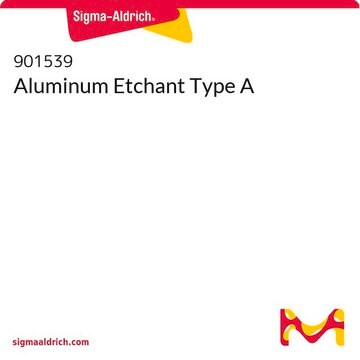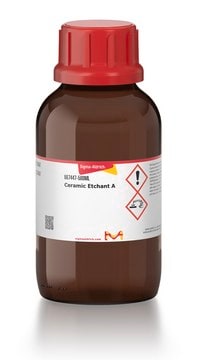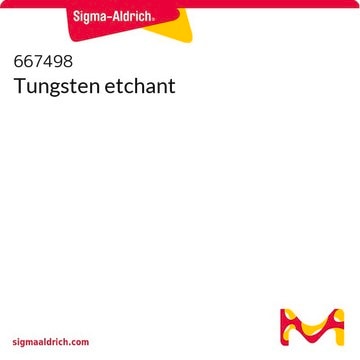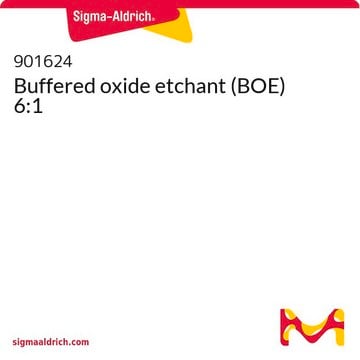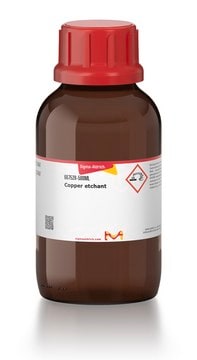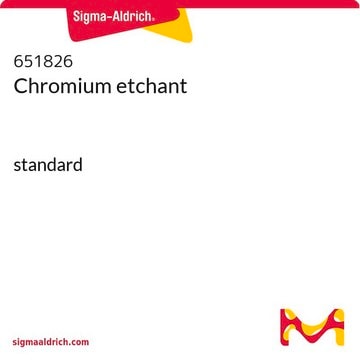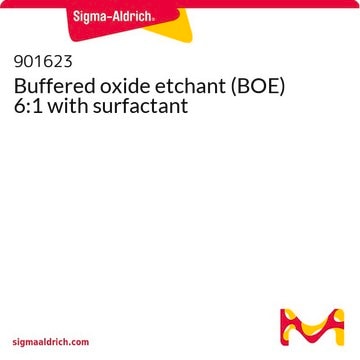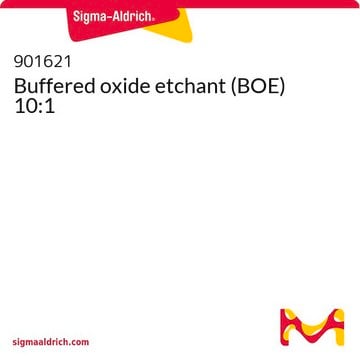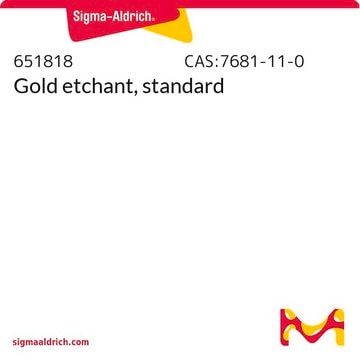901545
Aluminum Etchant Type D
Synonyme(s) :
Aluminum etching solution for use on gallium arsenide and gallium phosphide devices
About This Item
Produits recommandés
Forme
liquid
Description générale
- Standard aluminum etchant for use on gallium arsenide, arsenide and gallium phosphide devices and for aluminum metallizations on nichrome resistors
- Aluminum etchants are stable, non-toxic preparations used to etch aluminum metallizations on silicon devices and in integrated circuit applications. Aluminum contacts are defined, and interconnections are formed. These Aluminum Etchants, formulated with unique properties, easily overcome many of the difficulties experienced in aluminum etch processes.
- The aluminum metallization and etching process using photo-lithographic techniques is basic to semiconductor and microelectronic technology. Aluminum etchants are highly compatible with commercial photoresists and permit delineation into high resolution patterns. Metal line width of 1 mil and separations less than 5 microns are feasible. High resolution is practical with these aluminum etchants because lifting of photoresist patterns does not occur and undercutting is minimized. Furthermore, the etchants do not attack silicon, silicon dioxide, silicon nitride or nichrome resistor films.
- Two aluminum etchants are offered for use in microelectronics. Type A is recommended for use on silicon devices. Type D is recommended for use on gallium arsenide and gallium phosphide devices to avoid attack of the etchant on the intermetallic compound. It is also recommended for etching aluminum metallizations on nichrome thin film resistors.
Application
- Aluminum metallizations up to 25,000 Å are vacuum deposited on the silicon slice, coated with a photoresist, and UV exposed using an appropriate photographic mask. The resist is developed to protect the aluminum where interconnections are desired. Then the unprotected areas of the aluminum are removed by etching with the aluminum etchant, followed by a water rinse.
- Etching time is dependent upon the etchant temperature and the aluminum film thickness. When etching thick aluminum films, a higher etch rate is required; thus a higher etchant temperature should be used. Likewise, for thinner aluminum films, slower etch rates are desired and a lower etchant temperature should be chosen.
- At a specific etchant temperature, the etching time is given by the following formula:
where Etch Rate at 25°C 30 Å/sec; at 40°C 80 Å/sec.
Caractéristiques et avantages
- Controlled etch rates
- Selective etching: will not attack SiO2 or Si3N4
- Offers high resolution with minimal undercutting
- Eliminates smut formation
- Economical; reusable
Mention d'avertissement
Danger
Mentions de danger
Conseils de prudence
Classification des risques
Acute Tox. 4 Oral - Eye Dam. 1 - Flam. Liq. 3 - Met. Corr. 1 - Skin Corr. 1B - Skin Sens. 1
Code de la classe de stockage
3 - Flammable liquids
Classe de danger pour l'eau (WGK)
WGK 1
Certificats d'analyse (COA)
Recherchez un Certificats d'analyse (COA) en saisissant le numéro de lot du produit. Les numéros de lot figurent sur l'étiquette du produit après les mots "Lot" ou "Batch".
Déjà en possession de ce produit ?
Retrouvez la documentation relative aux produits que vous avez récemment achetés dans la Bibliothèque de documents.
Notre équipe de scientifiques dispose d'une expérience dans tous les secteurs de la recherche, notamment en sciences de la vie, science des matériaux, synthèse chimique, chromatographie, analyse et dans de nombreux autres domaines..
Contacter notre Service technique